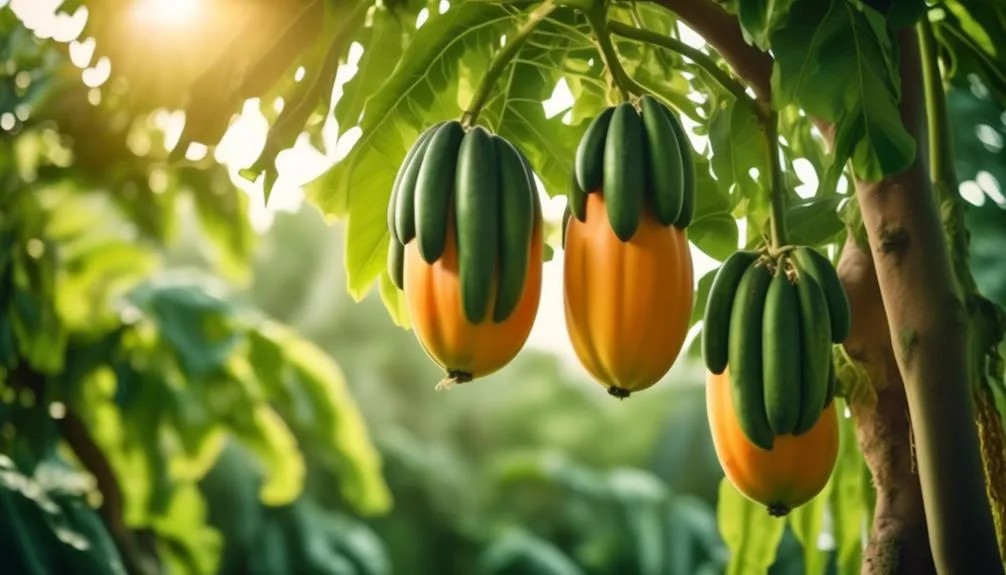
Ever dreamt of harvesting your own sweet, juicy papayas right from your backyard? The path to tropical fruit paradise starts with understanding your papaya tree's needs, and sunlight is a HUGE piece of the puzzle. Let's dive into the sunshine requirements of these fascinating plants and uncover the secrets to a bountiful papaya harvest.
Papaya Tree Sunlight Needs: Understanding the Basics
So, the big question: Do papaya trees like full sun? The short answer is a resoundingYES! Papaya trees are sun-worshippers through and through. They need plenty of sunlight to thrive, flower, and produce those delicious fruits we all crave. Think of them as tiny solar panels, converting sunlight into the energy needed to grow big and strong. Without enough sunshine, your papaya tree may struggle to reach its full potential, resulting in fewer fruits or even stunted growth.
The Importance of Full Sun for Papayas
Full sun, in gardening terms, generally means a location that receives at least6-8 hours of direct sunlight per day. This isn't just a recommendation; it's a necessity for papaya trees. Let's break down why sunlight is so crucial for their well-being:
Photosynthesis: Sunlight is the engine of photosynthesis, the process by which plants convert light energy into chemical energy (sugars) that fuel their growth. Papayas are fast-growing trees, which mean they have a high energy demand. Flowering and Fruiting: Adequate sunlight triggers the flowering process. Without sufficient sun exposure, your papaya tree may produce fewer flowers or, worse, no flowers at all! Fewer flowers naturally translate to fewer papayas. Disease Resistance: Strong sunlight helps papaya trees stay healthy and resist diseases. Sunlight helps to dry out the leaves, reducing the risk of fungal infections. Fruit Quality: Sunlight directly affects the taste and sweetness of the fruit. Papayas grown in full sun tend to be sweeter and more flavorful than those grown in shady conditions.
What Happens if Papaya Trees Don't Get Enough Sun?
Planting papaya trees without meeting their sun requirements can be detrimental to their growth and fruit production. Insufficient sunlight leads to several problems:
Leggy Growth: The tree will stretch towards available light, resulting in long, weak stems and sparse foliage. Reduced Flowering and Fruiting: As mentioned earlier, less sunlight means fewer flowers and ultimately fewer fruits. Pale Leaves: Chlorophyll, the pigment responsible for the green color in plants, relies on sunlight. Lack of sunlight can lead to pale or yellowing leaves (chlorosis). Increased Susceptibility to Diseases: Weakened trees are more vulnerable to pests and diseases. Slow Growth:The tree will grow at a much slower rate than it would under optimal conditions.
To make sure your gardening endeavors are fruitful, and you are able to grow juicy papayas, you might want to consider the KVR Upgraded Garden Kneeler and Seat with Thicken & Widen Soft Kneeling Pad, or as some would call it, the KVR Upgraded Gardener Stool. It is a perfect tool to make your gardening experience more comfortable. You can find it here: https://amzn.to/4mhl Mx I
Optimizing Sunlight Exposure for Your Papaya Tree
Now that we've established the importance of full sun, let's explore how to ensure your papaya tree receives adequate sunlight. Here are a few tips:
Choose the Right Location: Select a sunny spot in your garden that receives at least 6-8 hours of direct sunlight daily. Observe the area throughout the day to track sunlight patterns. Consider Sun Angles: Remember that the angle of the sun changes throughout the year. What might be a sunny spot in summer could be shaded in winter. Prune Overhanging Branches: If other trees or structures are casting shadows on your papaya tree, prune back branches to allow more sunlight to reach it. Reflect Sunlight: In areas with limited sunlight, consider using reflective surfaces (like white walls or reflective fabric) to bounce light towards your papaya tree. Avoid Competition:Don't plant your papaya tree too close to other large trees or shrubs that might compete for sunlight.
Sunlight and Papaya Tree Varieties
While all papaya trees need sunlight, there might be slight variations in their sun requirements based on variety. Some dwarf varieties, for example, might tolerate slightly less direct sunlight than taller, more vigorous varieties. However, even these varieties will still perform best in full sun. Here's a table to help illustrate:
| Papaya Variety | Sunlight Requirement | Notes |
|---|---|---|
| :-------------- | :------------------- | :------------------------------------------------------------------------------------------------------------------------------------------ |
| Mexican Red | Full Sun (6-8 hours) | Known for its large, sweet fruits; needs ample sunlight for optimal production. |
| Tainung No. 1 | Full Sun (6-8 hours) | A popular hybrid known for its disease resistance and high yield; thrives in full sun. |
| Dwarf Papaya | Full Sun (6-8 hours) | While generally smaller, it still needs full sun. May tolerate slightly less intense sunlight, but full sun is still ideal for fruit set. |
Remember to research the specific needs of your chosen papaya variety to ensure you're providing the best possible growing conditions.
In conclusion, while knowing the climate, soil and other factors are important,Do papaya trees like full sun?*Absolutely! Providing your papaya tree with plenty of sunlight is the key to unlocking its full potential and enjoying a bountiful harvest of delicious, homegrown papayas. So, choose a sunny spot, follow these tips, and get ready to enjoy the sweet rewards of your efforts!